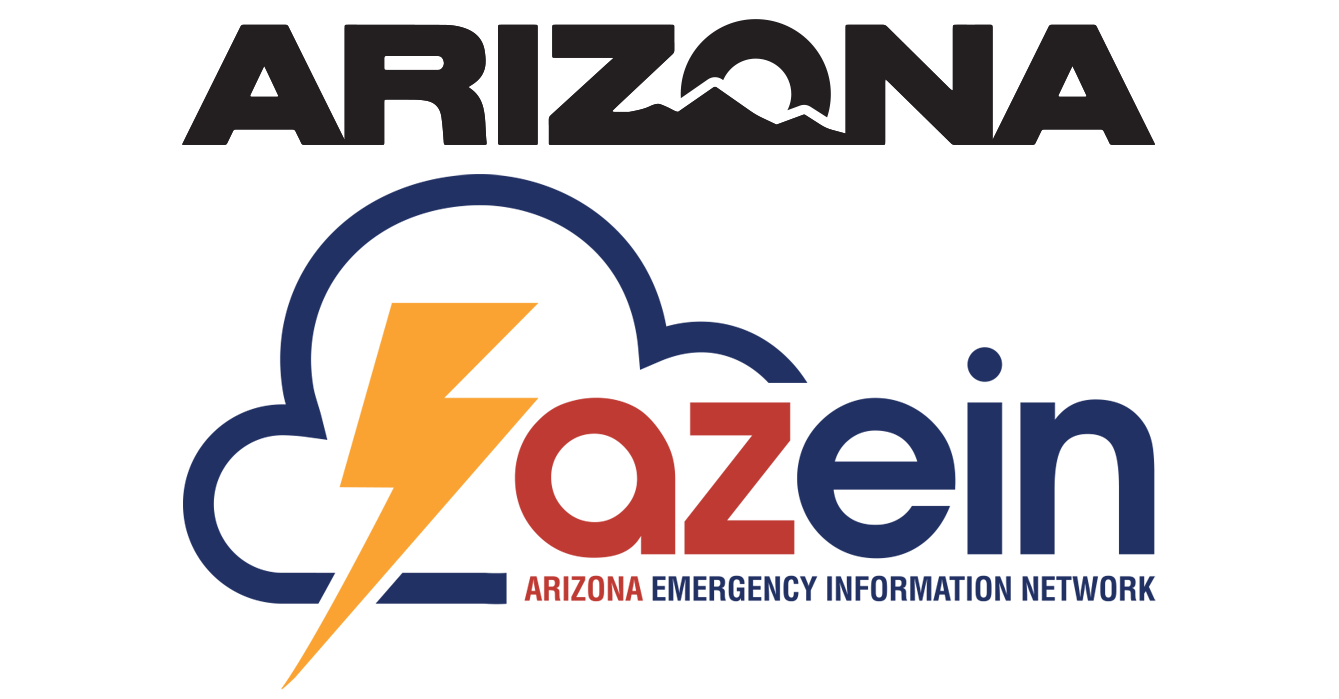Monsoon Awareness
Prepare for Monsoon | Turn Around, Don't Drown | Pull Aside, Stay Alive | When Thunder Roars, Go Indoors | Landslides and Debris Flow l Earth Fissures l Additional Resources
Monsoons are created when moisture meets with extreme summer heat and the humidity increases. This creates perfect conditions for weather hazards like heavy rain, high winds, lightning, dust storms and flash floods. Arizona's monsoon is from mid-June through the end of September. Learn more about the hazards that come along with the monsoon.
The summer's extreme heat can be life-threatening, especially to those who work outside, people over 65, children under five, and those with pre-existing medical conditions. Know the signs of dehydration, heat exhaustion and heat stroke. Reduce exposure to the sun and heat during peak hours.
The National Oceanic and Atmospheric Administration’s National Weather Service annually partners with, The Salvation Army, and the Arizona departments of Agriculture, Emergency and Military Affairs, Health Services, Insurance and Financial Institutions, Public Safety, Transportation, Water Resources and Environmental Quality to advocate severe weather preparedness.
Arizonans are encouraged to take the following actions in preparation for the season:
- Plan: Write and rehearse a family communication plan. The plan should identify a meeting place and include out-of-town contacts.
- Prepare: Build an emergency go kit with enough nonperishable food and water to last your family, including pets, for at least 72 hours. Include family prescriptions, copies of important documents and a weather radio. Additionally, include items such as face coverings, hand sanitizer and sanitizing wipes in your go kit to protect you and your family from illness.
- Inquire: Know what hazards are in your community and where you travel. Get current weather forecasts on TV, on the radio or online. Visit the hazard viewer and enter your address to learn about hazards in your area.
- Inspire: Be a preparedness example for others in your community. Check your home for potential hazards like overhanging trees and loose debris, get vaccinated for COVID-19, donate blood, do a fire drill at home, or check in with your neighbors about their plans for a power outage.
Due to the geographic makeup of our state, the weather can vary dramatically from region to region. When traveling throughout Arizona, pay attention to weather reports, watches and warnings, current conditions, conditions forecasted for the areas you are traveling through and conditions for your final destination.
Heavy monsoon rains can lead to flash flooding. Don’t underestimate the power of water. Six inches of fast-moving water can knock down an adult, and 18 inches of water can carry most vehicles away. Avoid low water crossings and areas that are already flooded. Never drive around barricades or attempt to cross streets with flowing water.
Strong monsoon winds can create large downbursts of air which create dense blowing clouds of dust that reduce visibility to near zero in seconds.
If you are caught in a dust storm, pull your vehicle off the roadway, place your vehicle in park, turn off your vehicle’s lights, and take your foot off the brake. Remain inside your vehicle with your seatbelt fastened and wait for the storm to pass.
Find quick tips for staying safe in a dust storm from the Arizona Department of Transportation.
When Thunder Roars, Go Indoors
Typically summertime leads to family vacations and outdoor activities. Whether it’s swimming, hiking, biking, or any other outdoor activity, pay attention to changes in the clouds and weather updates. Summer storms can move quickly and be deadly.
Lightning can strike from 10 miles away and spark fires which spread quickly if accompanied by high winds. If you can hear thunder, lightning is close enough to strike. If a storm approaches, head indoors or seek shelter, and remain indoors for at least 30 minutes after a storm passes before going back outside. This creates a safe distance from lightning and allows storm conditions to dissipate.
Landslides and Debris Flow
Landslides are caused by a variety of factors including: earthquakes, storms, volcanic eruptions, fire and human modification of land. Although some landslides require lengthy rain and saturated slopes, a debris flow can start on a dry slope after only a few minutes of intense rain, like Arizona’s monsoons. Learn more about landslides and debris flow.
Earth Fissures
Arizona has a unique and lesser known hazard: earth fissures. Earth fissures are cracks that appear in desert basin areas where ground sinking, aquifer depletion, alluvial soils, and monsoon rains combine. Fissure openings can be sudden and dynamic events.Torrential monsoon rains can rapidly widen and deepen fissures resulting in hazardous conditions to people, livestock and infrastructure.
Interested in learning more about ways to be prepared for the monsoon?
Check out these additional resources for more information:
Social Media:
- AzEIN Facebook and Twitter
- National Weather Service Phoenix Facebook and Twitter
- National Weather Service Tucson Facebook and Twitter
- National Weather Service Flagstaff Facebook and Twitter
- National Weather Service Las Vegas Facebook and Twitter
For more information on social media, follow #AzWX.
Preparedness Tips:
- Arizona Weather Dashboard
- Ready.gov
- Monsoon Brochure English and Spanish)
- Monsoon Awareness Week Webpage
- National Weather Service
- Arizona Department of Homeland Security
- Arizona Department of Insurance
- Arizona Department of Agriculture
- Arizona Department of Health Services
- Arizona Department of Environmental Quality
Monsoon Travel:
Beat the Heat:
Earth Fissure Information:

